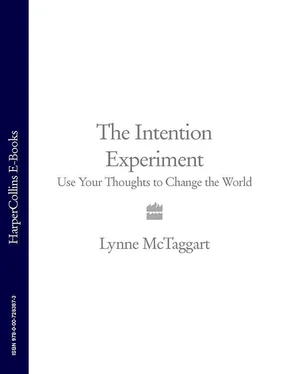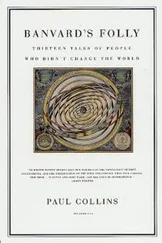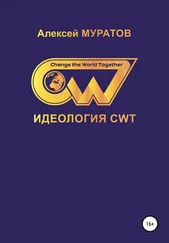The Vienna team scouted out some other molecules that were double the size and oddly shaped to see if geometrically asymmetric molecules also demonstrated the same magical properties. They settled on gigantic fluorinated American football-shaped molecules of 70 carbon atoms and pancake-shaped tetraphenylporphyrin, a derivative of the biodye present in chlorophyll. At more than 100 atoms apiece, both of these entities are among the largest molecules on the planet. Again, each one created an interference pattern with itself.
Zeilinger’s group repeatedly demonstrated that the molecules could be two places at once, which meant that they remained in a state of superposition even at this large scale. 25They had proved the unthinkable: the largest components of physical matter and living things exist in a malleable state. 26
Sai Ghosh didn’t often think about the implications of her discovery. She was content with the knowledge that her experiment had made a very nice paper, and might help along her career as an assistant professor involved in research into miniaturization, the direction she believed quantum mechanics was heading. Occasionally, she allowed herself to speculate that her crystal might have proved something important about the nature of the universe. But she was only a postgraduate student. What did she, after all, really know about how the world worked?
But to me, Ghosh’s research and Zeilinger’s work on the double-slit experiment represent two defining moments in modern physics. Ghosh’s experiments show that an invisible connection exists between the fundamental elements of matter, which is often so strong that it can override classical methods of influence, such as heat or a push. Zeilinger’s work demonstrated something even more astonishing. Large matter was neither something solid and stable nor something that necessarily behaved according to Newtonian rules. Molecules needed some other influence to settle them into a completed state of being.
Theirs were the first evidence that the peculiar properties of quantum physics do not simply occur at the quantum level with subatomic particles, but also in the world of visible matter. Molecules also exist in a state of pure potential, not a final actuality. Under certain circumstances, they escape Newtonian rules of force and display quantum non-local effects. The fact that something as large as a molecule can become entangled suggests that there are not two rule books – the physics of the large and the physics of the small – but only a single rule book for all of life.
These two experiments also hold the key to a science of intention – how thoughts are able to affect finished, solid matter. They suggest that the observer effect occurs not simply in the world of the quantum particle but also in the world of the everyday. Things no longer should be seen to exist in and of themselves but, like a quantum particle, only in relationship. Co-creation and influence may be a basic, inherent property of life. Our observation of every component in our world may help to determine its final state, which suggests that we are likely to be influencing every large thing we see around us. When we enter a crowded room, when we engage with our partners and our children, when we gaze up at the sky, we may be creating and even influencing at every moment. We can’t yet demonstrate this at normal temperatures; our equipment is still too crude. But we already have some preliminary proof: the physical world – matter itself – appears to be malleable, susceptible to influence from the outside.
Notes - Chapter 1: Mutable Matter
1. All personal information about Tom Rosenbaum and Sai Ghosh and their studies have been culled from multiple interviews conducted in February and March 2005.
2. This was the solution posed by Giorgio Parisi at Rome in 1979.
3. S. Ghosh et al., ‘Coherent spin oscillations in a disordered magnet’, Science , 2002; 296: 2195–8.
4. Once again, I am indebted to Danah Zohar for her easy-to-digest description of quantum non-locality, which appears in D. Zohar, The Quantum Self , London: Bloomsbury, 1991: 19–20.
5. A. Einstein, B. Podolsky and N. Rosen, ‘Can quantum-mechanical description of physical reality be considered complete?’ Physical Review , 1935; 47: 777–80.
6. A. Aspect et al., ‘Experimental tests of Bell’s inequalities using time-varying analyzers’, Physical Review Letters , 1982; 49: 1804–7; A. Aspect, ‘Bell’s inequality test: more ideal than ever’, Nature , 1999; 398: 189–90.
7. Science Fact: Scientists achieve ‘Star Trek’-like feat – The Associated Press, December 10, 1997, posted on CNN, http://edition.cnn.com/TECH/9712/10/beam. me. up. ap.
8. Non-locality was considered to be proven by Aspect et al.’ s experiments in Paris in 1982.
9. J. S. Bell, ‘On the Einstein-Poldolsky-Rosen paradox’, Physics , 1964; 1: 195–200.
10. S. Ghosh et al., ‘Entangled quantum state of magnetic dipoles’, Nature , 2003; 435: 48–51.
11. Details of Vedral’s views and experiments the result of multiple interviews, February, October and December 2005.
12. C. Arnesen et al., ‘Thermal and magnetic entanglement in the 1D Heisenberg Model’, Physical Review Letters , 2001; 87: 017901.
13. V. Vedral, ‘Entanglement hits the big time’, Nature , 2003; 425: 28–9.
14. T. Durt, interview with author, April 26, 2005.
15. B. Reznik, ‘Entanglement from the vacuum’, Foundations of Physics , 2003; 33: 167–76; Michael Brooks, ‘Entanglement: The weirdest link’, New Scientist , 2004; 181 (2440): 32.
16. John D. Barrow, The Book of Nothing , London: Jonathan Cape, 2000: 216.
17. Erwin Laszlo, The Interconnected Universe: Conceptual Foundations of Transdiscipinary Unified Theory , Singapore: World Scientific Publishing, 1995: 28.
18. A. C. Clarke, ‘When will the real space age begin?’ Ad Astra , May–June 1996; 13–15.
19. Harold Puthoff, ‘Ground state of hydrogen as a zero-point-fluctuation-determined state’, Physical Review D , 1987; 35: 3266.
20. B. Haisch, Alfonso Rueda and H. E. Puthoff, ‘Inertia as a zero-point-field Lorentz force’, Physical Review A , 1994; 49 (2): 678–94; Bernhard Haisch, Alfonso Rueda and H. E. Puthoff, ‘Physics of the zero-point field: implications for inertia, gravitation and mass’, Speculations in Science and Technology , 1997; 20: 99–114.
21. Various interviews with Hal Puthoff, 1999–2000.
22. Reznik, ‘Entanglement from the vacuum’, op. cit.
23. McTaggart, The Field , op. cit.: 35–6.
24. J. Resch et al., ‘Distributing entanglement and single photons through an intra-city, free-space quantum channel’, Optics Express , 2005; 13 (1): 202–9; R. Ursin et al., ‘Quantum teleportation across the Danube’, Nature , 2004; 430: 849.
25. M. Arndt et al., ‘Wave–particle duality of C60 molecules’, Nature , 1999; 401: 680–2; doi: 10.1038/44348.
26. A. Zeilinger, ‘Probing the limits of the quantum world’, Physics World , March 2005 (online journal: http://www.physicsweb.org/articles/world/18/3/5/1).
CHAPTER TWO
IN 1951, AT THE AGE OF SEVEN, Gary Schwartz made a remarkable discovery. He had been trying to get a good picture on the family’s television set. The recently acquired black and white Magnavox set encased behind the doors of its boxed walnut console fascinated him, not because of the people in the moving pictures so much as the means by which they arrived in his living room in the first place. The mechanisms of the relatively new invention remained a mystery, even to most adults. Television, like any other electrical gadget, was something the precocious child longed to take apart and understand. This passion had already found expression with the worn-out radios given to him by his grandfather. Ignatz Schwartz sold replacement tubes for televisions and radios in his drug store in Great Neck, Long Island, and those that were beyond repair were handed over to his grandson to disassemble. In a corner of Gary’s bedroom lay a mass of experimental debris – tubes, resistors and the carcasses of radios heaped on the cosmetic display racks he had borrowed from his grandfather – the first signs of what would become a lifelong fascination with electronics.
Читать дальше











